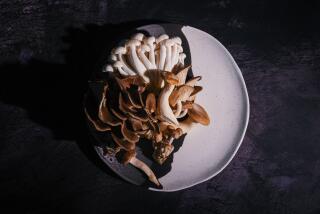Don’t Worry; Be Happy! A Fungus Is Among Us
- Share via
One of the hottest developments in gardening these days is not a new plant or a nifty garden gadget: It’s mycorrhizae fungi.
Found at the root zone of most plants, mycorrhizae are good for the garden. Yet, while as abundant and as old as soil itself, they have only recently begun to be marketed to home gardeners.
Scientists believe that the fungi developed right along with plants. In order to survive the stresses of extreme temperatures, drought, soil infertility and pests, plants needed to form larger root systems, so they invited in the mycorrhizae, which can scavenge in the far reaches of soil for water and nutrients.
Researchers have discovered seven main types of such fungi; all have specific host plants.
The fungi, commercially available in the past year or so, are usually sold in a granular clay form or within soil or sand and added to the soil surrounding the target plants.
Most plants don’t need a mycorrhizae boost; the fungus is already present in established root systems. The places where gardening experts are seeing a use for it are in new housing tracts where the topsoil has been disturbed, in container gardening and in large areas that won’t be tended--like hillsides.
What these previously little-known fungi do is develop a mutually beneficial relationship with plants, says Edith Allen, a botanist who is natural resources extension specialist in the department of Botany and Plant Sciences at UC Riverside.
“Mycorrhizae help plants take up nutrients and water,” Allen says. “For their work, the fungi receive carbon from plant roots, which is their own source of food. In nature, where plants don’t have access to irrigation or fertilizer, mycorrhizae are critical for the survival of plants.”
Despite their small size, these fungi are able to develop such a massive secondary root system that plants are able to take up much more water and nutrients than would be otherwise possible, says Robert Sparnicht, a plant pathologist with J. Harold Mitchell Co. Inc., in San Gabriel, which carries a variety of mycorrhizal inoculum for home and commercial use.
“Mycorrhizae also form a protective barrier around plant roots against dangerous diseases and pathogens like phytophthora, which has killed off many plants this year after our wet winter,” Sparnicht says. Phytophthora is a fungus that thrives in over-wet soil and causes root rot.
*
Although there is agreement that mycorrhizae exist and they are good for the soil, experts aren’t sure that adding them to every home garden is necessary.
“I’m a bit skeptical about widespread home use of mycorrhizae,” says Ted St. John, a plant ecologist at the Tree of Life Nursery in San Juan Capistrano, were California native plants are inoculated with mycorrhizae.
“If a person has been treating their soil well and not dumping on a lot of chemical fertilizers [which will kill off mycorrhizae], they will generally have a good population of the fungi already. But if someone wants to try it, it won’t do any harm, and in some cases it may be useful.”
Mycorrhizae are present in established gardens, Allen says. “Given enough time, you can hardly keep them out,” she says. “Although they don’t travel far on their own, they come in on bugs and other creatures and sometimes through the air.”
Experts point to three situations in which the home gardener might see benefits in using mycorrhizae.
* In the soil in a new home tract, where the topsoil has been stripped and moved around, Allen says. “The resulting exposed subsoil has very little life in it and no mycorrhizae, making it nearly impossible for plants to survive. So we suggest adding the fungi when planting or bringing in new topsoil that contains it.”
* Mycorrhizae tend to be useful in containers because potting soil is essentially sterile.
* They are thought to be helpful in out-of-the-way areas such as hillsides that are planted and then left alone.
Beyond those situations, there is less agreement about when it’s beneficial for home gardeners to use mycorrhizae, but some plant growers and nurseries are beginning to take the little fungi seriously.
At White Flower Nursery Company in Los Angeles they’ve been using mycorrhizae for five years. The wholesaler grows ornamental plants for independent nurseries throughout Southern California.
“We’re a small nursery and we’ve been using the fungi as a way to compete with the larger nurseries,” says Craig Shiozaki, the company’s chief propagator. “With the fungi we’ve been able to provide our customers with plants that perform much better than usual. Plants known to have trouble in our clay soils, such as gardenias and azaleas, thrive in the ground when inoculated with mycorrhizae.”
At Laguna Hills Nursery in Lake Forest, they’ve been testing mycorrhizae, also with good results. Recognizing the importance of the fungi, they’ve even changed the planting instructions they give to customers.
“When planting, we now suggest that you don’t turn the soil over as was once recommended, because doing so disrupts the mycorrhizae and sterilizes the soil,” says nursery president Gary Matsuoka. “Instead we tell customers to dig a hole, set the plant inside, and replace the backfill the same way it came out.”
If you are considering using mycorrhizae in your landscape, research the type you need. Certain kinds are for certain plants, and some aren’t affected by the fungi at all.
“Plants in the mustard family such as mustard greens, radishes, cabbage, cauliflower, broccoli and Brussels sprouts don’t respond to the inoculum,” St. John says. “Other plants that aren’t benefited by it include beets, spinach, Swiss chard and amaranth. If any of these plants do respond, the inoculum has been doctored with fertilizer.”
Crops that do especially well when given inoculum include strawberries, grapes, many perennial crops, almost any fruit tree (especially citrus), onions, carrots, corn, squash, cucumbers, pumpkins, melons, beans, peas, artichokes, asparagus, most herbs, eggplant, peppers, celery, garlic, raspberries, boysenberries, potatoes, tomatoes, blueberries, oak trees, pine trees and turf grass.
Mycorrhizae are most effective when introduced to young plants but can be added to established plants.
Opinions differ on how to best add the fungi--some experts advise introducing it at the root zone and planting directly above it, while others advise introducing it into the backfill soil.
To add to an existing plant in the landscape, such as a tree, Sparnicht suggests creating 6- to 8-inch holes in the soil with a broom handle every 2 feet in a staggered, circular pattern, starting about 3 feet inside of the tree’s drip line and going out twice the distance of the drip line.
Mix the fungi into each hole and then cover with soil. The mycorrhizae should come in contact with the tree’s feeder roots, which are in the top 8 inches of soil and spread out way beyond the drip line.
Once mycorrhizae are added to the soil, re-application is usually not necessary, as long as you keep them happy. To keep mycorrhizae thriving, experts suggest avoiding chemical fertilizers, which tend to be strong and are known to reduce the mycorrhizal population.
“If plants are grown in highly fertile soil, they will reject the fungi because they don’t need it,” says Allen. “Overwatering will also cause a decrease.”
Use an organic fertilizer such as bone meal, blood meal, sea kelp, cottonseed meal or fish emulsion and make sure to not overwater.






